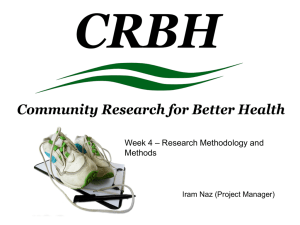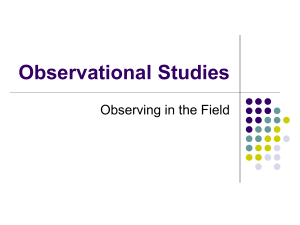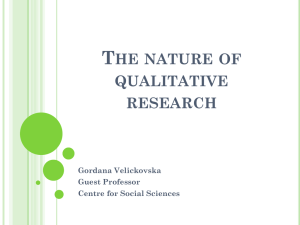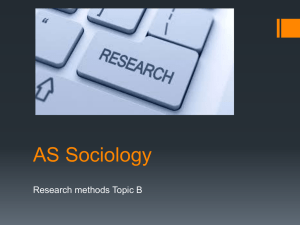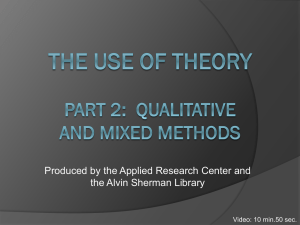Qualitative Social Work Research
advertisement
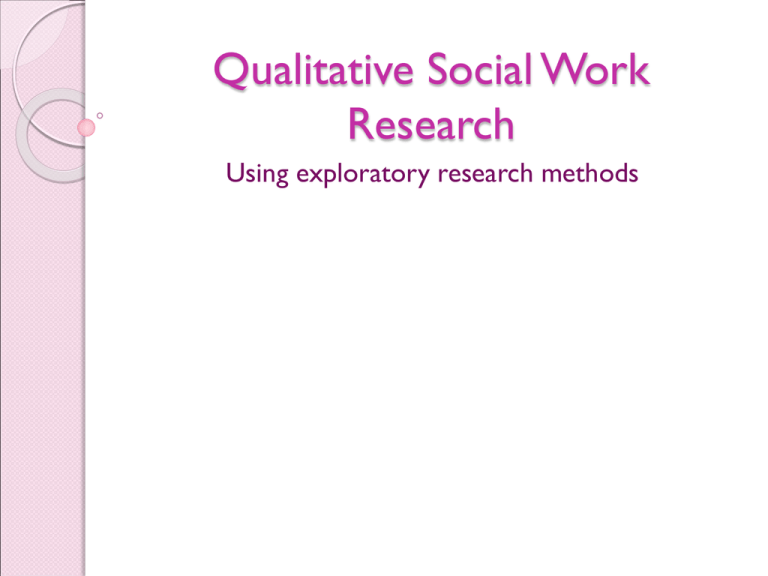
Qualitative Social Work Research Using exploratory research methods Last semester you talked about three approaches to research Exploratory Descriptive Explanatory (hypothesis-testing) This semester will focus on one type of methodology EXPLORATORY OR QUALITATIVE METHODS Qualitative methods are used when: There is limited previous research on a topic. When there is literature about this problem, but we know little about how a particular population group experiences a problem. When you want to know about culture values and norms When you want to develop some new ideas about how a problem should be addressed based on hunches or practice experience. When the social work researcher is interested in learning about the experiences and perspectives of underserved populations. When the social work researcher is interested in developing new interventions for underserved populations. When the researcher is interested in finding out about how people perceive or experience a program, policy, or service. When a researcher is interested in learning about how or why a program or policy works. Quantitative research is the term used to describe:: Descriptive and explanatory methods. Hypothesis testing. The use of statistical data to confirm findings. Testing previous theories. Producing “objective” data. Examining the effects of interventions, experiments, programs, or policies. Describing what has occurred in specific situations or people’s opinions using pre-developed research questions and response categories. Data collected from a systematic or randomly collected sample that is used to assess what is happening in a larger population (generalization). Replication of research from a previous study. In qualitative research: We do not test hypothesis or previous theories. We may try to develop new theories based on what happens in specific situations. We do not try to generalize our findings. We rely on data collected from interviews, observations, and content analysis of newspapers, books, videos, case records, and other already developed documents. We do not know or try to develop response categories prior to conducting the study. Qualitative research is sometimes called, “Naturalistic Inquiry” Meaning that the researcher just reports on what’s there – and does not try to manipulate or intervene in any way. Sometimes naturalistic inquiry is compared to newspaper reporting. These two approaches are: Both considered to be valid types of empirical research. Are paradigms (sets of different assumptions or worldviews about how research is to be conducted). Can be used in combination with one another. Differences between qualitative and quantitative research Involves unstructured interviews, observation, and content analysis. Subjective Inductive Little structure Little manipulation of subjects Takes a great deal of time to conduct Little social distance between researcher and subject Involves experiments, surveys, testing, and structured content analysis, interviews, and observation. Objective Deductive High degree of structure Some manipulation of subjects May take little time to conduct Much social distance between researcher and subject One way to think about the difference between Deductive and Inductive methods is to think about “Detectives.” Detectives apply general theories to revolve problems (a quantitative approach). Qualitative researchers examine what happens in specific situations and try to develop new theories based on that situation. IN QUALITATIVE RESEARCH We use the following methods to conduct research: Answer research questions rather than test a hypothesis. Seldom look at the effectiveness of an intervention. Examine the perceptions, actions, and feelings of participants. Obtained detailed information from interviews, content analysis, or observations. WHEN WE SAY THAT QUALITATIVE RESEARCH IS SUBJECTIVE We mean that: Participants in a research study have unique opinions, perceptions, experiences, values, and beliefs. In our research, we will try to accurately reflect their perceptions values, opinions, experiences, and beliefs. In our data analysis, we will look for both commonalities and differences in opinions, perceptions, values, and beliefs. The researcher’s opinions, perceptions, values, beliefs, and experiences affect how the researcher analyzes and communicates data collected from respondents. THE RESEARCHER’S Own perceptions are important!!! The researcher is the “instrument” through which observations and interviews are filtered. The researcher’s own experiences, education, and perceptions shape what he or she observes or hears. In writing up results, the researcher incorporates those perceptions into the data analysis. The researcher may differentiate what she or he thinks from what she or he feels in reaction to a situation. IN THIS CLASS: We will accomplish several goals: We will focus on skills used by qualitative researcher. We will examine situations in which researcher uses qualitative rather than quantitative methods. We will examine ethical issues associated with qualitative research. We will examine how qualitative research is used to empower people, work for social justice, and is used to produce culturally competent research and social work interventions. All materials are on Dr. Hardina’s web page: http://zimmer.csufresno.edu/~do nnah Textbook is: Padgett, D. K. (1998). Qualitative methods in social work research. Thousand Oaks, CA: Sage Publications. Articles are also posted in the library’s electronic reserve system and you can download other reading materials directly from the Internet. METHODS OF INSTRUCTION Include: Lectures In-class exercises Film and Audio Clips Skill-building assignments Guest lecturers Final exam (essay) COURSE ASSIGNMENTS include Activity Weight Points Assignment #1 – Article Deconstruction 10.0% 40 Assignment #2 - Observation 10.0% 40 Assignment #3 – Development of Interview Guide 10.0% 40 Assignment #4 – Transcript of Interview 10.0% 40 Assignment #5 – Coding Guide/Report on Research Findings 25.0% 100 Final Exam 25.0% 100 Attendance 10.0% 40 100.0% 400 Total

